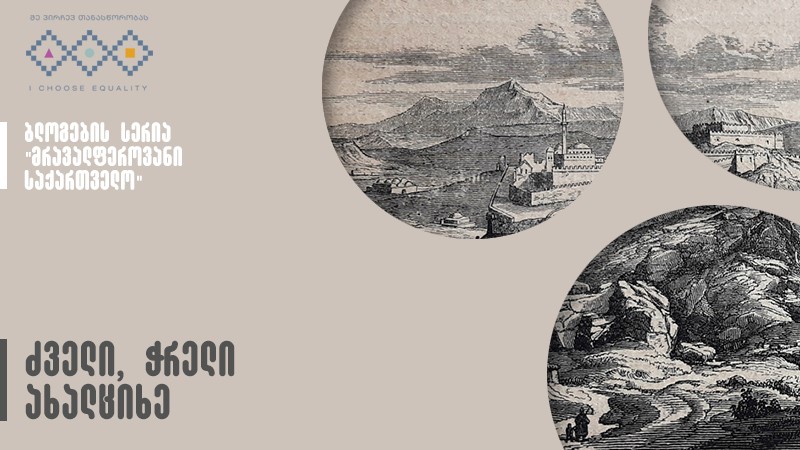Author: Sulkhan Saladze
From the 17th century, Akhaltsikhe became a meeting place for people of different ethnic, religious and cultural backgrounds. The famous Dutch cartographer and shipbuilder, Nicolaes Witsen, referred to the 17th century Akhaltsikhe, Samtskhe Saatabago, as a large city. Samtskhe-Javakheti at that time was spread over a wide area and included many parts of land and gorges in the historical south-west of Georgia.
Unique location and importance of Akhaltsikhe is also indicated by the fact that you can see it a lot on old maps. For example, on the map of the Black Sea by Jean Chardin, published by Moses Pitt in London in 1686; the Map of the Caspian Sea and Surrounding Countries published in 1723 by Guillaume Delisle in Paris (with contribution of Sulkhan-Saba) and in the French version of the map of Vakhushti Batonishvili's "Kingdom of Georgia" published in Paris by Joseph-Nicolas Delisle in 1766.
Many Georgian and foreign travelers have described the diversity of life in Old Akhaltsikhe, its role and location. Naming them all would take us too far, however it would not be a good practice to not mention anyone either.
When talking about the diversity of Akhaltsikhe, we can use the records of Turkish traveler Evliya Çelebi, French jeweler Jean Chardin and Georgian geographer and historian Vakhushti Batonishvili.
Among them, Akhaltsikhe was first visited by Turkish traveler Evliya Çelebi in 1647. According to the traveler Akhaltsikhe was a charming fortress-like town standing on a steep hill. The fortress had a fence and two gates. Inside the prison there were up to 1,100 houses without vineyards and gardens, roofed with soil. There were also three mosques without minaret in the town. One could see 300 shops, a market and two hazelnut trees in the outskirts of the fortress. Beautiful vegetable gardens and crops were growing around Akhaltsikhe. According to the Turkish traveler, the inhabitants of Akhaltsikhe were strong, brave and glorified people.
After the travels of Evliya Çelebi in 1672, Akhaltsikhe was visited by Jean-Chardin. According to Jean-Chardin, Akhaltsikhe was a fortress built on mountains, located in a cave and surrounded by twenty hills. There was a small town on hills nearby, with four hundred newly built wooden houses. According to the French traveler, Georgians, Turks, Greeks, Armenians and Jews lived in Akhaltsikhe. There also were churches and a synagogue in Akhaltsikhe.
Later in the 18th century, Vakhushti Batonishvili emphasized the ethnic diversity of Akhaltsikhe when he wrote – “And the town is surrounded by a fortress with three borders of mortared stone. Those inside are noble and distinct Muslims, and merchants. Armenians, Urians and people of Meskheti also dwell there.”
As a rule, Georgian Muslims and Orthodox Christians living in Akhaltsikhe did not favor trade much. However, Georgian Catholics, Armenians and Jews from Akhaltsikhe were engaged in trade. As to rest of the country, Catholics from Akhaltsikhe used to trade in Kutaisi the most. This is evidenced by a letter sent by General Gorchakov to Governor Ermolov in 1823, informing General Ermolov that 146 of the 150 shops in the Kutaisi market belonged to Akhaltsikhe Catholics. The way Georgian Catholics from Akhaltsikhe used to trade and travel outside Georgia is even more interesting. In this regard, Khursidzes, Zubalashvilis, Mepisashvilis and Chilingarashvilis were especially advanced. Merchants from Akhaltsikhe could be seen in Constantinople, Tabriz, Kars, Trabzon… Some Georgian Catholics from Akhaltsikhe even used to go to Europe and India to trade in the 17th and 18th centuries. According to Zakaria Chichinadze, Georgian Catholic merchants had their own caravans in Indian cities – Kolkata and Madras.
By the 1820s, Akhaltsikhe was such an advanced town that according to the French consul in Tbilisi, Jean-François Gamba, the city's population, including the surrounding areas, reached 40,000. Akhaltsikhe at that time was a town full of life with churches, mosques, synagogues, guilds, caravans and diverse ethnic or cultural composition.
According to sources, the old town was built in tiers on the slope of the castle. A catholic church stood at the top, from there the settlement reached the banks of the river Potskhovi. The houses stood neatly next to each other. The roof of one house was a playground for another. Citadel and Rabat were mostly inhabited by Muslims, while a mint was operating on Jiritmoedani.
In the 1850s the city was divided into the following main districts - Rabat (including the Jewish area); Upper and Lower Mardi Settlements and "Plan", also known as the new part of the town. In the 1860s, Akhaltsikhe had about 50 streets, 5 squares, 6 bridges, 8 churches (out of which 2 were Orthodox, 3 Armenian and 3 Catholic) and 1 synagogue, indicating the coexistence of people of different ethnic, religious and cultural backgrounds.
A great deal of time has passed since the 17th century. A lot has changed, a lot has disappeared and was forgotten, however even today you can still feel diversity in Akhaltsikhe every step of the way.




